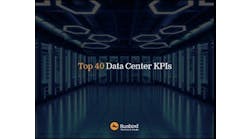USG Report: DOE Targets Clean Energy for AI Infra; NTIA Probes Data Center Security, Resilience
To meet the news demands of the data center industry’s unprecedented expansion, USG Report is a new periodic feature at Data Center Frontier chronicling the burgeoning activity of the U.S. Government (USG) within and toward all spheres of the data center industry.
Here you’ll find coverage of initiatives and announcements emanating from key federal agencies, departments and national laboratories, as pertains to the data center industry’s rapidly oncoming, increasingly complex future.
DOE Advises on Powering AI, Data Center Infrastructure
The U.S. Department of Energy (DOE) recently highlighted a series of DOE resources and assistance programs intended to help industry leaders and partners in the data center, electric vehicle (EV) and manufacturing segments meet exponentially growing clean energy demands.
As part of these efforts, the agency’s Secretary of Energy Advisory Board (SEAB) on Powering AI and Data Center Infrastructure in July released a report entitled, Recommendations on Powering Artificial Intelligence and Data Center Infrastructure.
Providing 16 recommendations for how the DOE can help support growing power demand reliably and affordably, the report considers power dynamics for AI model training, as well as operational flexibility for data center and utility operators, while evaluating the most promising generation and storage technologies to meet load growth.
As rendered by the SEAB Working Group’s report:
"Data center power demands are growing rapidly. Connection requests for hyperscale facilities of 300-1000 MW or larger with lead times of 1-3 years are stretching the capacity of local grids to deliver and supply power at that pace. A significant factor today and in the medium-term (2030+) is expanding power demand of AI applications. Advancements in both hardware and software have enabled development of large language models (LLMs) that now approach human capabilities on a wide range of valuable tasks.
As these models have grown larger, so have concerns about sizeable future increases in the energy to deploy LLMs as AI tools become more deeply woven into society. With DOE’s leadership role in energy efficiency, clean energy deployment, innovative grid technologies, and AI-related energy consumption and research, the department can play a central role in helping the nation meet these new, strategic energy needs. "
The Challenge Ahead
The DOE's SEAB Working Group on Powering AI and Data Center Infrastructure took as its mandate an examination of options for supporting the industry’s gigantically growing power demands reliably and affordably -- without harming existing customers and while limiting greenhouse gas emission impacts.
The Working Group said its inquiry proceeded along three closely coordinated tracks:
- 1. Examination of energy efficiency and power dynamics in LLM training and inference.
- 2. Exploration of an operational flexibility framework to address current bottlenecks, based upon active collaboration between electricity companies and data center developers and operators.
- 3. Study of generation and storage technologies available today and in the future, examining approaches to more accurately project power needs, address supply chain constraints, and accelerate deployment at scale.
In its methodology, the SEAB Working Group reached out to a diverse set of data center industry stakeholders to solicit their views. These stakeholders included:
• Hyperscalers: Amazon, Google, Meta, Microsoft, OpenAI
• Data center developers/innovators: Blackstone/QTS Data Centers, Digital Realty, Verrus
• Technology providers: Fervo, General Electric, Hitachi, Intel, HPE, Long Duration Energy Storage Council, Nvidia
• Electricity companies: Associated Electric Cooperative, Constellation, Duke Energy, Evergy, NPPD, NextEra, PPL, Portland General, PSEG, Southern Company/Georgia Power, Vistra
• Independent system operators and regional transmission operators: CAISO, MISO, PJM, SPP
Datacenter Dynamics’ Sebastian Moss has provided a useful breakdown of the report’s most salient implications for data centers.
DOE, ORNL Target HPC Supercomputing
Meanwhile, on Sept. 6, the DOE Office of Science announced a new research and development opportunity led by Oak Ridge National Laboratory (ORNL) to advance High-Performance Computing (HPC) technologies and drive new capabilities for future supercomputers.
The government’s $23 million New Frontiers industry research program will initiate partnerships with multiple companies “to accelerate the R&D of critical technologies with renewed emphasis on energy efficiency for the next generation of post-exascale computing in the 2029 and beyond time frame.”
“There is a growing consensus that urgent action is needed to address an array of bottlenecks in advanced computing, including energy efficiency, advanced memory, interconnects, and programmability to maintain economic leadership and national security,” said Ceren Susut, associate director of DOE’s Office of Science for Advanced Scientific Computing Research.
Susut added, “Through the Exascale Computing Project, we partnered with industry to provide critical advances for the nation, but much more work remains to be done and the opportunities and challenges of AI underscore the need for continued government investment.”
In 2022, the Frontier system at Oak Ridge became the first supercomputer to officially exceed one quintillion calculations per second on the Top500 list, officially beginning the industry’s Exascale Era, as chronicled by DCF.
NTIA, Dept. of Commerce Issue RFC Supporting U.S. Data Center Growth
On Sept. 4, the Department of Commerce’s National Telecommunications and Information Administration (NTIA) -- the agency responsible for administering the $42.45 billion Broadband Equity, Access, and Deployment (BEAD) Program charged with expanding the nation’s fiber infrastructure -- launched an inquiry into how federal policy can support the growth of U.S. data centers to meet the coming demand from AI and other emerging technologies.
The NTIA’s thusly announced Request for Comment (RFC) on Bolstering Data Center Growth, Resilience and Security seeks input on opportunities to balance data center market growth with supply chain resilience and data security.
NTIA is issuing the RFC in coordination with the U.S. Department of Energy (DOE), in alignment with DOE’s stated mission to ensure American’s security and prosperity through addressing energy challenges with science and technology solutions.
Supply chain challenges cited by the NTIA’s RFC include access to trusted equipment, energy demand, the need for a specialized workforce, and land availability. The RFC seeks comment on these issues and others, including:
- The market considerations data centers deem critical when seeking to modernize or expand.
- The potential positive and negative impacts of data center modernization or investment on society.
- The requirements data centers that host AI models should implement to ensure adequate data security practices.
The input received in response to the RFC will be used to develop a report with policy recommendations for how the U.S. government can foster sustainable, resilient and secure data center growth. The full RFC states:
"The National Telecommunications and Information Administration (NTIA) hereby requests comments on the challenges surrounding data center growth, resilience and security in the United States amidst a surge of computing power demand due to the development of critical and emerging technologies.
This request focuses on identifying opportunities for the U.S. government to improve data centers’ market development, supply chain resilience, and data security. NTIA will rely on these comments, along with other public engagements on this topic, to draft and issue a public report capturing economic and security policy considerations and policy recommendations for fostering safe, secure, and sustainable data center growth."
Written comments for the RFC must be received on or before November 4, 2024.
NTIA’s announcement noted that while there are more than 5,000 data centers in the United States, demand for data centers in the United States is projected to grow by 9% annually through 2030.
“Data centers are the backbone of a secure and resilient technology ecosystem,” said Assistant Secretary of Commerce for Communications and Information and NTIA Administrator Alan Davidson. “But projections show we don’t have enough data centers in the United States to meet growing demand and power the coming AI revolution. Our inquiry will lead to policy approaches that encourage the sustainable growth of this essential computing infrastructure across the country.”
Among the speakers at this month's Data Center Frontier Trends Summit (Sept. 4-6) in Reston, Virginia was Maureen Russell, Acting Deputy Associate Administrator, Telecommunications for the NTIA's Office of Policy Development and Analysis.

Matt Vincent
A B2B technology journalist and editor with more than two decades of experience, Matt Vincent is Editor in Chief of Data Center Frontier.





